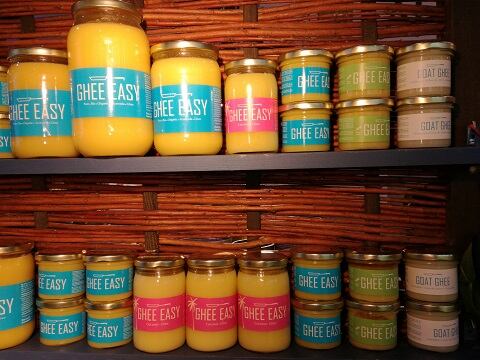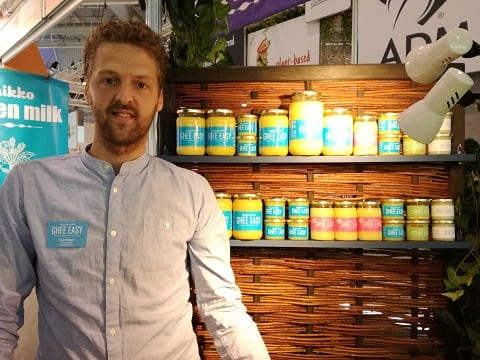A traditional cooking oil in South Asia, ghee is clarified butter made by boiling butter, which evaporates the water and separates the fat and milk proteins. Solid proteins are removed by filtration and what remains is a lactose-free butterfat that has a smoke point of 250 °C.
Dutch start-up Ghee Easy was founded five years ago by three friends, David Klingen, Bela de Briun and Andres Giel.
“Coconut oil really kicked off over the past 10 years […] and we are the next trend,” said co-founder and CEO Klingen, speaking to FoodNavigator at SIAL yesterday. “With ghee, people have the rich flavour of butter plus the added benefit that they can fry at high temperatures."
The company has four products in its range - plain, rosemary, Indian spice and goat ghee - and although Klingen did not disclose how much it sells in volume terms, he said it has seen its turnover double every year over the past four years.
Big fat confusion

According to Klingen, the success of ghee as a cooking ingredient is also “partly” down to the fact that people are confused about oils and fats, and which ones are healthy.
Ghee contains 99. 8 g fat, of which 62.5 g is saturated fat.
Firstly, he said, for years, food manufacturers have developed low-fat and diet foods by replacing fat with sugar, creating products that claim to be healthy but are not.
Secondly, the unhealthiness of saturated fats is increasingly called into doubt. Although most national nutrition guidelines continue to endorse unsaturated, plant-based fats such as sunflower oil from a health stance, trending diets such as keto and paleo have fuelled the popularity of unprocessed fats, including foods high in saturated fat.
Consumers are also increasingly curious about culinary alternatives, Klingen said.
“Before, the only fats we used in Northern Europe were butter and lard. Then people discovered you could press seeds and plants and get oil from that too. My parents’ generation grew up without olive oil - they only used sunflower oil - but every kitchen in Europe today has a bottle of olive oil and now every hipster kitchen has coconut oil.
“People want to learn about fats that are traditionally used elsewhere and people are open to cooking with new things,” he added.
Only organic
After working as sustainability manager for big retailers such as Ahold and Jumbo, Klingen said he got bored of sitting in front of a computer all day and was looking for something more hands-on.
Inspiration for creating a business in ghee came from having a mother who was passionate about Ayurveda, meditation and Indian cooking. “Now I’m back in front of the computer all day because we’re growing too fast,” he added.
Although the company does not have “a mission to change the world with ghee”, on principle, it sources butter from grass-fed, organic cows only.
“We do organic because we believe there is room for animals in this world only if we treat them well. Taking all the nutrients out of the soil on one side of the world so that we can grow the crops to feed cows on the other side– which is how the dairy system works – makes no sense.”
Organic farming “feels like it’s better for the next generation,” Klingen added.
The company initially sourced all its butter from the Netherlands but had to diversify to neighbouring countries such as Germany, Belgium, Denmark and the UK to ensure steady supplies.
Big in Japan
In addition to online platforms, the brand is sold in bricks-and-mortar retailers in the Netherlands, UK and France including Sainsbury’s, Planet Organic and Whole Foods.
Surprisingly – even for the company itself – it has found success in Japan, with sales there now accounting for 25% of its turnover.
“I don’t know why it appeals to the Japanese so much. We were even on TV over there and Ghee Easy was in the top 10 most sold food products on Amazon Japan.”
The Dutch start-up is also by far the dominant player in Japan where Ghee Easy products make up 80% of all ghee sold, according to Klingen – although it is still a very small, niche category in the country.
All flavours are available in 100 g jars while the plain ghee is available in 100 g, 245 g, 500 g and 850 g jars. The company also sells in bulk for B2B customers and supplies private label manufacturers.
Two years ago, Ghee Easy launched a beverage brand, Chikko Not Coffee with three caffeine-free products – chicory, spelt and turmeric golden latte – all available in instant powder format.
Chikko is now outpacing the ghee products in terms of growth, but the clarified butter still accounts for 95% of its business, Klingen said.

